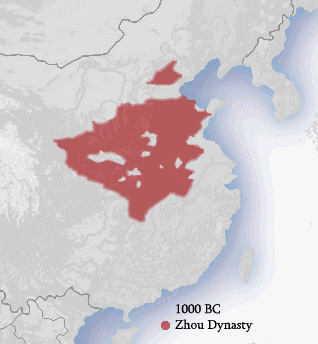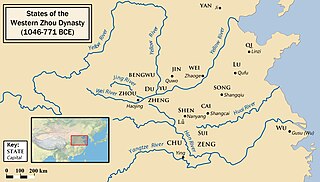Related Research Articles

The 7th century BC began the first day of 700 BC and ended the last day of 601 BC.
The 8th century BC started the first day of 800 BC and ended the last day of 701 BC. The 8th century BC was a period of great change for several historically significant civilizations. In Egypt, the 23rd and 24th dynasties lead to rule from Kingdom of Kush in the 25th Dynasty. The Neo-Assyrian Empire reaches the peak of its power, conquering the Kingdom of Israel as well as nearby countries.

The Zhou dynasty was a royal dynasty of China that existed for 789 years from c. 1046 BC until 256 BC, the longest such reign in Chinese history. During the Western Zhou period, the royal house, surnamed Ji, had military control over ancient China. Even as Zhou suzerainty became increasingly ceremonial over the following Eastern Zhou period (771–256 BC), the political system created by the Zhou royal house survived in some form for several additional centuries. A date of 1046 BC for the Zhou's establishment is supported by the Xia–Shang–Zhou Chronology Project and David Pankenier, but David Nivison and Edward L. Shaughnessy date the establishment to 1045 BC.

The Spring and Autumn period in Chinese history lasted approximately from 770 to 481 BCE which corresponds roughly to the first half of the Eastern Zhou period. The period's name derives from the Spring and Autumn Annals, a chronicle of the state of Lu between 722 and 481 BCE, which tradition associates with Confucius. During this period, royal control over the various local polities eroded as regional lords increasingly exercised political autonomy, negotiating their own alliances, waging wars amongst themselves, up to defying the king's court in Luoyi. The gradual Partition of Jin, one of the most powerful states, is generally considered to mark the end of the Spring and Autumn period and the beginning of the Warring States period.

The Western Zhou was a period of Chinese history, approximately first half of the Zhou dynasty, before the period of the Eastern Zhou. It began when King Wu of Zhou overthrew the Shang dynasty at the Battle of Muye and ended when Quanrong pastoralists sacked its capital Haojing and killed King You of Zhou in 771 BC.

King You of Zhou, personal name Ji Gongsheng, was the twelfth king of the Chinese Zhou dynasty and the last from the Western Zhou dynasty. He reigned from 781 to 771 BC.
King Nan of Zhou, less commonly known as King Yin of Zhou, was the 37th and last king of the Chinese Zhou dynasty, the son of King Shenjing of Zhou and grandson of King Xian of Zhou. He was king from 314 BC until his death in 256 BC, a reign of fifty-nine years, the longest in the Zhou Dynasty and all of pre-imperial China. By the time of King Nan's reign, the kings of Zhou had lost almost all political and military power, as even their remaining crown land was split into two states or factions, led by rival feudal lords: West Zhou, where the capital Wangcheng was located, and East Zhou, centred at Chengzhou and Kung. Therefore, Nan lacked any personal territory and was effectively under the control of the local feudal lords, essentially relying on their charity.

Zheng was a vassal state in China during the Zhou Dynasty located in the centre of ancient China in modern-day Henan Province on the North China Plain about 75 miles (121 km) east of the royal capital at Luoyang. It was the most powerful of the vassal states at the beginning of the Eastern Zhou, and was the first state to clearly establish a code of law in its late period of 543 BCE. Its ruling house had the ancestral name Ji (姬), making them a branch of the Zhou royal house, who held the rank of Bo (伯), a kinship term meaning "elder".
Wangcheng was an ancient Chinese city located beside the ceremonial eastern capital of Luoyi during the Zhou dynasty. It was constructed in 1021 BC on the model of the earlier and larger Chengzhou 15 kilometers (9.3 mi) to its east. It was the primary capital of the Eastern Zhou dynasty between 771 and 510 BC.
Marquis Wen of Jin, ancestral name Ji (姬), given name Chou (仇), was the eleventh ruler of the state of Jin. He was also the first ruler of Jin in the Spring and Autumn period.
Hao or Haojing, also called Zongzhou (宗周), was one of the two settlements comprising the capital of the Western Zhou dynasty, the other being Fēng or Fēngjīng (灃京). Together they were known as Fenghao and stood on opposite banks of the Feng River (沣河): with Feng on west bank and Hao on the east bank. Archaeological discoveries indicate that the ruins of Haojing lie next to the Feng River around the north end of Doumen Subdistrict (斗门街道) in present-day Xi'an, Shaanxi Province. It was the center of government for King Wu of Zhou.
Duke Xiang of Qin aka by his nomen ,Ying Kai ,was from 777 to 766 BC the sixth ruler of the Zhou Dynasty vassal state of Qin, which eventually unified China to become the Qin Dynasty. His ancestral name was Ying ,Kai as his nomen and Duke Xiang was his posthumous title. He was the first Qin ruler to be granted a nobility rank by the king of Zhou; under his reign, Qin was formally recognized as a major vassal state of Zhou China.
Duke Zhuang I of Qi was from 794 to 731 BC the twelfth recorded ruler of the State of Qi during the Zhou dynasty of ancient China. His personal name was Lü Gou (呂購), ancestral name Jiang, and Duke Zhuang was his posthumous title. He was the first of the two Qi rulers called Duke Zhuang.
Duke Ping of Chen, given name Xie (燮), was the tenth ruler of the ancient Chinese state of Chen during the transition period from the Western Zhou dynasty to the Spring and Autumn period. Ping was his posthumous name.
The following outline is provided as an overview of and topical guide to ancient China:

The Eastern Zhou is a period in Chinese history comprising the latter half of the Zhou dynasty from c. 771 BCE to 256 BCE, following the Zhou capital's relocation eastward to Chengzhou, near present-day Luoyang. The Eastern Zhou was characterised by the weakened authority of the Zhou royal house, it is subdivided into two parts: the Spring and Autumn period, during which the ancient aristocracy still held power in a large number of separate polities, and the Warring States period, which saw the consolidation of territory and escalation of interstate warfare and administrative sophistication.

Yiqu, was an ancient Chinese state which existed in the Hetao region and what is now Ningxia, eastern Gansu and northern Shaanxi during the Zhou dynasty, and was a centuries-long western rival of the state of Qin. It was inhabited by a semi-sinicized people called the Rong of Yiqu, who were regarded as a branch of western Rong people by contemporary writers, whom modern scholars have attempted to identify as one of the ancestors of the minority people in Northwest China.
Duke Wu of Zheng, personal name Ji Juetu, was the second ruler of the Zheng state during the Spring and Autumn period in ancient China. He assumed the throne after his father, Duke Huan of Zheng, was killed alongside King You of Zhou in a 771 BC Quanrong attack on the Western Zhou capital Haojing. Duke Wu, alongside Duke Xiang of Qin supported King Ping of Zhou's flight to Chengzhou by securing the Central Plains, where Duke Huan had previously relocated Zheng. Duke Wu later annexed the states of Eastern Guo, Hu (胡), Kuai, and Ji (祭).
References
- ↑ Crabb, George (1833). Universal Historical Dictionary: Or Explanation of the Names of Persons and Places in the Departments of Biblical, Political and Eccles. History, Mythology, Heraldry, Biography, Bibliography, Geography, and Numismatics. Baldwin and Cradock. p. 91.
- ↑ Chen, Fei (2020). Study on the Synchronistic King list from Ashur. Leiden. p. 200. ISBN 978-90-04-43092-1. OCLC 1152355809.
{{cite book}}: CS1 maint: location missing publisher (link) - ↑ Art, Authors: Department of Asian. "Shang and Zhou Dynasties: The Bronze Age of China | Essay | The Metropolitan Museum of Art | Heilbrunn Timeline of Art History". The Met’s Heilbrunn Timeline of Art History. Retrieved 2024-05-11.